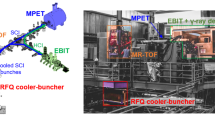Abstract
The development of storage rings and electromagnetic traps for heavy charged particles is opening up new regimes of atomic physics, including, in particular, spectroscopic studies of Rydberg helium-like ions — with nuclear chargeZ, one electron in the 1s state, and one electron in a near-hydrogenic state of highn andl <n, withn andl the principal and orbital quantum numbers, respectively. We consider the possibility of detecting energy shifts due to retardation, ΔE ret (n,l), Casimir-like effects. These are quantum electrodynamic (QED) retardation effects associated with the finite speed of light. (As opposed to basically kinematic and dynamic QED effects for small quantum numbersn andl, the appropriate expansion parameter forn andl large for retardation QED corrections is notZ(e 2/ħc) but [(Z − 1)/n 2 Z 2](ħc/e 2).) We wish to provide some orientation to those planning experiments in the area, with regard to the choices ofn,l, andZ most likely to be able to generate a high-precision confirmation of a retarded interaction. To do so, we provide extensive tables of estimates, for 1s,nl states, of ΔE ret(n,l), of radiative widths, and ofE, the spin-independent (“electric” fine structure) energy in the absence of retardation shifts, for (nuclear spin zero) ions withZ=2, 6, 8, 16 and 20. These ions might be experimentally accessible in storage rings, and theZ's are low enough that virtual pair production effects may not yet be significant. There is also a brief survey of possible experimental techniques.
Similar content being viewed by others
References
Habs, D., et al.: Nucl. Instrum. Methods B43, 390 (1989)
Datz, S.: Nucl. Instrum. Methods B24, 3 (1987)
Schuch, R.: Nucl. Instrum. Methods B24, 11 (1987)
Martinson, I.: Rep. Prog. Phys.52, 157 (1989)
Kelsey, E.J., Spruch, L.: Phys. Rev. A18, 15 (1978)
Babb, J.F., Spruch, L.: Phys. Rev. A36, 456 (1987);38, 13 (1988)
Drachmann, R.J.: Phys. Rev. A31, 1253 (1985);26, 1228 (1982)
Drake, G.W.F.: Phys. Rev. Lett.65, 2769 (1990); States up ton=10,l=7 for He have been studied. See also: Drake, G.W.F.: In: Long range forces: Theory and recent experiments in atomic systems. Levin, F.S., Micha, D. (eds.). New York: Plenum Press 1992
Spruch, L.: Phys. Today39 (11), 37 (1986). This improves on the arguments of Spruch, L., Kelsey, E.J.: Phys. Rev. A18, 845 (1978)
Feinberg, G., Sucher, J., Au, C.K.: Ann. Phys. (N.Y.)173, 355 (1987)
Martin, W.C.: Phys. Scr.24, 725 (1981)
Physically, retardation is significant when a characteristic time of flight of a virtual photon is comparable to or larger than the period of the 1s electron. Mathematically, withE exc a characteristic excitation energy of the 1s electron and withE γ a characteristic energy of a virtual photon, one hasE exc/E γ ≈ αZ ≪ 1 for a helium atom or a low-Z two-electron ion in a low-lying state, andE γ/E exc ≈ (Z − 1)/(n 2αZ 2) ≪ 1 for sufficiently high Rydberg states. See Spruch, L., Babb, J.F.: In: Spectroscopy and collisions of few-electron ions. Ivascu, M., Florescu, V., Zoran, V. (eds.). Singapore: World Scientific 1989. In treating terms such as 1/(E exc +E γ), one then expands in powers ofE exc/E γ in the one case and in powers ofE γ/E exc in the other
Aldridge, J.P., Skofronick, J.G.: Phys. Rev. Lett.28, 529 (1972)
Hessels, E.A., Deck, F.J., Arcuni, P.W., Lundeen, S.R.: Phys. Rev. Lett.65, 2765 (1990);66, 2544E (1991)
Lundeen, S.R.: In: Atomic physics. Vol. 12, Zorn, J.C., Lewis, R.R. (eds.). New York: American Institute of Physics 1991
Chang, E.S.: Phys. Rev. A31, 495 (1985)
Afanaseva, N.V., Grudzdev, P.F.: Opt. Spektrosk.55, 416 (1983) [Opt. Spectrosc. (USSR)55, 245 (1983)]
Marxer, H., Spruch, L.: Phys. Rev. A43, 1268 (1991)
Drake, G.W.F.: J. Phys. B22, L651 (1989); Goldman, S.P., Drake, G.W.F.: Phys. Rev. Lett.68, 1683 (1992)
Sugar, J., Corliss, C.: J. Phys. Chem. Ref. Data. [Suppl. 2]14, 9 (1985)
Moore, C.E.: Natl. STand. Ref. Data Ser. Natl. Bur. Stand.3, Sec. 8 (1979)
Martin, W.C., Zalubas, R., Musgrove, A.: J. Phys. Chem. Ref. Data19, 821 (1990)
Au, C.K., Feinberg, G., Sucher, J.: Phys. Rev. Lett.53, 1145 (1984), and references therein. For an alternative derivation see [6]
Au, C.K.: Phys. Rev. A31, 1310 (1985)
Kelsey, E.J., Spruch, L.: Phys. Rev. A18, 1055 (1978)
Mittleman, M.H., Watson, K.M.: Phys. Rev.113, 198 (1959); Kleinman, C.J., Hahn, Y., Spruch, L.: ibid.165, 53 (1968); Dalgarno, A., Drake, G.W.F., Victor, G.A.: ibid.176, 194 (1968)
Bethe, H.A., Salpeter, E.E.: Quantum mechanics of one- and two-electron atoms. New York: Academic Press 1957
Omidvar, K.: At. Data Nucl. Data Tables28, 1 (1983)
Omidvar, K.: Phys. Rev. A26, 3053 (1982)
Goldwire, H.C.: Astrophys. J. [Suppl. Ser.]17, 445 (1968)
Neumann, R., Poth, H., Winnacker, A., Wolf, A.: Z. Phys. A — Atoms and Nuclei313, 253 (1983)
Schramm, U., Berger, J., Grieser, M., Habs, D., Jaeschke, E., Kilgus, G., Schwalm, D., Wolf, A., Neumann, R., Schuch, R.: Phys. Rev. Lett.67, 22 (1991)
Omidvar, K., Guimaraes, P.T.: Astrophys. J. [Suppl. Ser.]73, 555 (1990)
Bell, M., Bell, J.S.: Part. Accel.12, 49 (1982)
Habs, D., Kramp, J., Krause, P., Matl, K., Neumann, R., Schwalm, D.: Phys. Scr. T22, 269 (1988)
Marrus, R., Mohr, P.J.: Adv. At. Mol. Phys.14, 181 (1978)
Bockasten, K.: Phys. Rev. A9, 1087 (1974)
Author information
Authors and Affiliations
Rights and permissions
About this article
Cite this article
Babb, J.F., Habs, D., Spruch, L. et al. Retardation (Casimir) energy shifts for Rydberg helium-like low-Z ions. Z Phys D - Atoms, Molecules and Clusters 23, 197–209 (1992). https://doi.org/10.1007/BF01437395
Received:
Issue Date:
DOI: https://doi.org/10.1007/BF01437395




